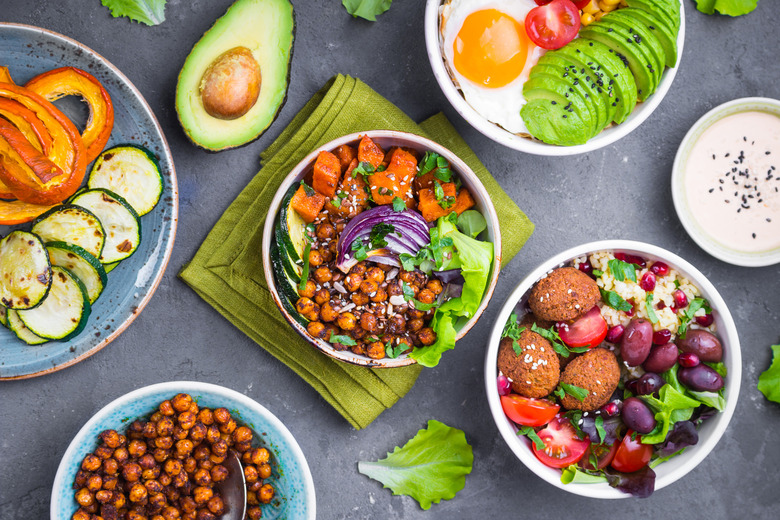Buddha Never Would Have Eaten Buddha Bowls
Well, he might have eaten simple bowls of grains and plants. But he certainly wouldn't have eaten the types of "Buddha bowls" we've grown to consume. If you ask 10 different people what "Buddha bowl" means, you'll get 10 different answers. A bowl topped with an egg. A huge bowl of raw plants. Some grains served with cooked vegetables.
We took to the ultimate authority on food and drink trends — Instagram — and found out what meals the term "Buddha bowl" is really used to describe.
The top result was a bowl of chickpea pasta doused in "cheesy" vegan pasta sauce. This mixture was added on top of a bowl of zucchini noodles, an egg, avocado, leafy greens, and sauerkraut. Oh, and a bajillion spices.
Buddha bowls were just a ton of seemingly unrelated ingredients thrown together in one expansive round bowl. Whatever creative and enticing-looking way the Instagrammer came up with to serve his or her food would pass — so long as the bowl was round and contained mostly vegetables.
Some Buddha bowls we found were vegan. Others were filled with fruit. Almost all of them showcased an avocado. But it seems the things every Buddha bowl had in common were their artful arrangements, elaborate cooking and/or seasoning of plant-based ingredients, and an immense portion of food.
Records of Buddha's diet are somewhat hazy (considering the fact that he lived over two millennia ago and his teachings were finally written down a few hundred years after his death). Most people agree that Buddha avoided eating meat, but that debate is contentious. Buddhist scholars cite multiple lines of scripture detailing his instructions to avoid killing animals for consumption, yet never asserting a steadfast rule. Other accounts suspect that Buddha's last meal was wild boar. It's all very confusing.
But all records of Buddha and his diet agree on one thing: Buddha didn't care much for elaborate meals and he didn't emphasize the exact foods that he chose to eat. In fact, Buddha didn't have much control over what he ate at all — local villagers donated most of his monks' fare.
Mentions of the Buddha eating in scripture detail simple, one- or two-component meals. They involve a lot of rice, honey, fruits, and vegetables. The Buddha also was frequently recorded as eating sweets: Custards, sugarcane, cake, and molasses. These provisions were given to the Buddha or one of his monks as a charitable deed. Buddha didn't slave over pots and pans or spend time and energy cooking.
Instead, his food was meant to be simple. Some Buddhists avoid eating the five "pungent" vegetables: onions, garlic, chives, green onions, and leeks. According to the Śūraṅgama Sūtra, these plants have "ill-effects" on human beings.
"If these five are eaten cooked, they increase one's sexual desire; if they are eaten raw, they increase one's anger," the text reads. Some believe that Buddha avoided the plants because of their suspected effect on hormones and liver function.
But regardless of the reasons why, it's doubtful that the Buddha was eating these elaborately cooked, garlic-soaked meals. He certainly wasn't eating anything covered in more than a few simple spices. And for the most part, he made do with the food that was made readily available. Elaborateness and decorum was farthest from his mind when it came to his food.
Plant-based eating isn't always as complicated as it looks on Instagram. There are plenty of simple meatless dinners that don't require sculpting an avocado — perhaps Buddha ate some of those.
